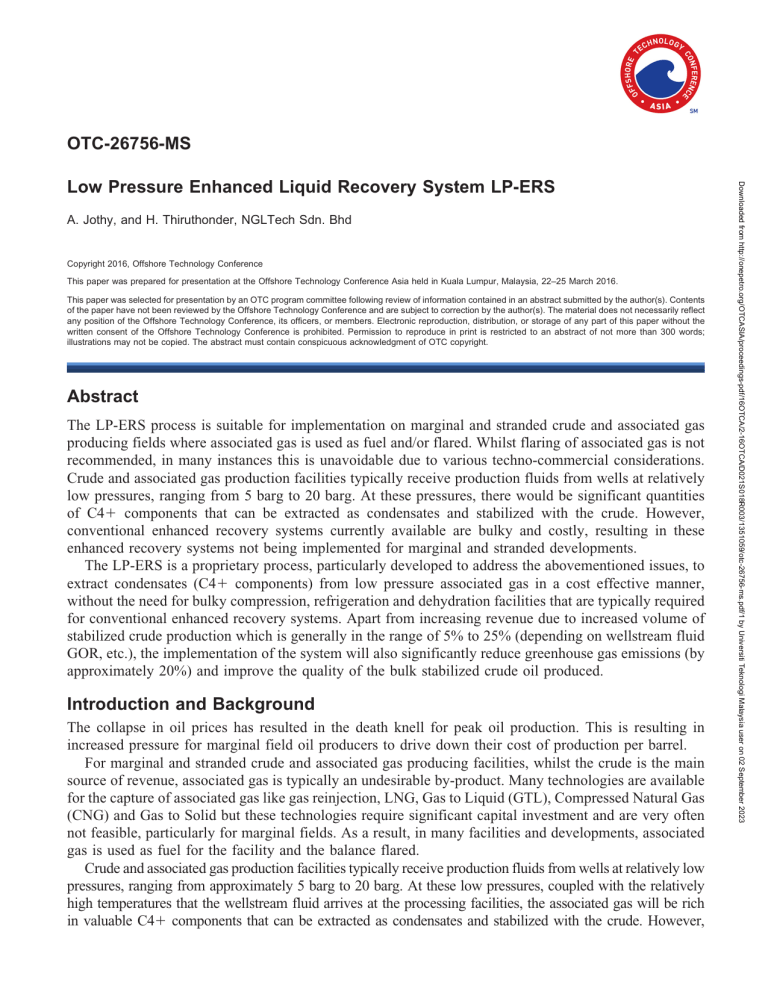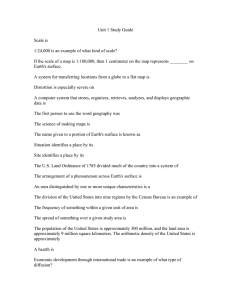
OTC-26756-MS A. Jothy, and H. Thiruthonder, NGLTech Sdn. Bhd Copyright 2016, Offshore Technology Conference This paper was prepared for presentation at the Offshore Technology Conference Asia held in Kuala Lumpur, Malaysia, 22–25 March 2016. This paper was selected for presentation by an OTC program committee following review of information contained in an abstract submitted by the author(s). Contents of the paper have not been reviewed by the Offshore Technology Conference and are subject to correction by the author(s). The material does not necessarily reflect any position of the Offshore Technology Conference, its officers, or members. Electronic reproduction, distribution, or storage of any part of this paper without the written consent of the Offshore Technology Conference is prohibited. Permission to reproduce in print is restricted to an abstract of not more than 300 words; illustrations may not be copied. The abstract must contain conspicuous acknowledgment of OTC copyright. Abstract The LP-ERS process is suitable for implementation on marginal and stranded crude and associated gas producing fields where associated gas is used as fuel and/or flared. Whilst flaring of associated gas is not recommended, in many instances this is unavoidable due to various techno-commercial considerations. Crude and associated gas production facilities typically receive production fluids from wells at relatively low pressures, ranging from 5 barg to 20 barg. At these pressures, there would be significant quantities of C4⫹ components that can be extracted as condensates and stabilized with the crude. However, conventional enhanced recovery systems currently available are bulky and costly, resulting in these enhanced recovery systems not being implemented for marginal and stranded developments. The LP-ERS is a proprietary process, particularly developed to address the abovementioned issues, to extract condensates (C4⫹ components) from low pressure associated gas in a cost effective manner, without the need for bulky compression, refrigeration and dehydration facilities that are typically required for conventional enhanced recovery systems. Apart from increasing revenue due to increased volume of stabilized crude production which is generally in the range of 5% to 25% (depending on wellstream fluid GOR, etc.), the implementation of the system will also significantly reduce greenhouse gas emissions (by approximately 20%) and improve the quality of the bulk stabilized crude oil produced. Introduction and Background The collapse in oil prices has resulted in the death knell for peak oil production. This is resulting in increased pressure for marginal field oil producers to drive down their cost of production per barrel. For marginal and stranded crude and associated gas producing facilities, whilst the crude is the main source of revenue, associated gas is typically an undesirable by-product. Many technologies are available for the capture of associated gas like gas reinjection, LNG, Gas to Liquid (GTL), Compressed Natural Gas (CNG) and Gas to Solid but these technologies require significant capital investment and are very often not feasible, particularly for marginal fields. As a result, in many facilities and developments, associated gas is used as fuel for the facility and the balance flared. Crude and associated gas production facilities typically receive production fluids from wells at relatively low pressures, ranging from approximately 5 barg to 20 barg. At these low pressures, coupled with the relatively high temperatures that the wellstream fluid arrives at the processing facilities, the associated gas will be rich in valuable C4⫹ components that can be extracted as condensates and stabilized with the crude. However, Downloaded from http://onepetro.org/OTCASIA/proceedings-pdf/16OTCA/2-16OTCA/D021S018R003/1351059/otc-26756-ms.pdf/1 by Universiti Teknologi Malaysia user on 02 September 2023 Low Pressure Enhanced Liquid Recovery System LP-ERS 2 OTC-26756-MS Description of Concept The concept uses a simple J-T Valve based dew point control unit (DPCU) that is modified for low pressure applications (termed LP DPCU) to extract condensates from the low pressure associated gas stream by the chilling process. The chilling duty for the Gas Chiller of the LP DPCU is derived by evaporative cooling of inhibited fresh water using the leaned-out (and in the process, dehydrated) associated gas from the LP DPCU in an Evaporator Column prior to the gas being flared. The cold condensates extracted from the chilled associated gas at the LP DPCU is then contacted with rich flash gas from the final stage of the crude stabilization train to strip out light ends (C3- components) from the condensates and to absorb heavy ends (C4⫹ components) from the rich flash gas. The stripped condensate is then comingled with crude production and stabilized in the crude stabilization multistage separator train to meet the product TVP and RVP specifications. Figure 1—Recovery Process Development Downloaded from http://onepetro.org/OTCASIA/proceedings-pdf/16OTCA/2-16OTCA/D021S018R003/1351059/otc-26756-ms.pdf/1 by Universiti Teknologi Malaysia user on 02 September 2023 conventional enhanced recovery systems that are currently available for extraction of C4⫹ components from gas stream are bulky and costly, resulting in these enhanced recovery systems not being implemented for marginal and stranded developments. To process low pressure gas, these conventional enhanced recovery systems, will require booster compression and/or mechanical refrigeration, gas dehydration, etc. which significantly add to space, weight, complexity and cost of the facility and this makes these systems technocommercially not viable for marginal developments. A proprietary compact, self-contained process unit that is specifically tailored for enhanced stabilized crude recovery from production facilities operating at low pressures in the range of 5 barg to approximately 20 barg or more, known as Low Pressure Enhanced Recovery System (LP-ERS) has been developed. This system maximizes the recovery of C4⫹ components from the associated gas and stabilizes the recovered condensate and crude to meet the typical final product specification, True Vapor Pressure (TVP) and Reid Vapor Pressure (RVP), of typically 12 psia and 10 psia respectively. This is achieved with the added benefit of significantly reducing the greenhouse gases (CO2) emissions due to burning associated gas as fuel or flaring. The LP-ERS operates at rather low pressure whilst maintains the good performance of increasing stabilized crude production depending on the production rate, fluid compositions and Gas Oil Ratio (GOR) of the production fluid. The low pressure feature of the system makes the implementation of this technology more economically viable through the elimination of booster compression and/or refrigeration system, dehydration, etc. thus reducing the size, weight and overall capital cost. The system configuration is simple, compact and easily retrofitted on existing facilities. The system has minimal moving parts and easily operable thus providing high system availability and maintainability. Furthermore, the system is designed to enable continuous production with the existing system while the LP-ERS is off-line for maintenance. OTC-26756-MS 3 Detailed Description of Technology Figure 2 shows the typical configuration of the LP-ERS. The process consists of 3 main unit operations: 1. Low Pressure Dew Point Control Unit (LP DPCU) 2. Flash Gas/Condensate Contactor 3. Chilled Water Generation System Figure 2—Typical Configuration of LP-ERS Low Pressure Dew Point Control Unit (LP DPCU) The following figure illustrates the dewpoint control and condensate recovery from associated gas at low pressure. The main components of the LP DPCU comprises of the following: ● ● ● ● Gas Chiller Gas/Gas Heat Exchanger Low Temperature Separator J-T Valve Downloaded from http://onepetro.org/OTCASIA/proceedings-pdf/16OTCA/2-16OTCA/D021S018R003/1351059/otc-26756-ms.pdf/1 by Universiti Teknologi Malaysia user on 02 September 2023 The condensates extracted not only increases the stabilized crude volumes but also improves the crude quality by increasing its API Gravity and reducing its viscosity. Also, the extraction of the C4⫹ components from the associated gas improves the quality of the gas as the gas product will be leaner. In situations where the associated gas is used as fuel gas or flared, the CO2 (greenhouse gas) emissions are reduced by an average of approximately 20%. The system configuration is simple, compact and easily retrofitted on existing facilities as the system requires minimal external utilities. The system has minimal moving parts and easily operable thus providing high system reliability and availability with low maintenance requirements. Furthermore, the system is designed to enable continuous production with the existing system while the LP-ERS is off-line for maintenance. 4 OTC-26756-MS Figure 3—Schematic of Conventional and LP-ERS J-T Valve System The following figure shows the phase envelope of the associated gas stream with the benefit of locating the J-T Valve downstream of the Low Temperature Separator when the gas pressure is low. Based on the figure below, it is shown that the LP-ERS cooling yields higher condensate recovery (Quality line of 0.35) as compared to the Conventional J-T Valve system (Quality line of 0.15). Using the conventional configuration, only 2344 bpd of condensate is recovered whereas LP-ERS J-T Valve System recovers 2771 bpd of condensate. Figure 4 —Phase Envelope with Quality Line Downloaded from http://onepetro.org/OTCASIA/proceedings-pdf/16OTCA/2-16OTCA/D021S018R003/1351059/otc-26756-ms.pdf/1 by Universiti Teknologi Malaysia user on 02 September 2023 The associated gas stream is chilled with Gas Chiller and it is then routed to the Gas-Gas Heat Exchanger. A closed loop Chilled Water system which supplies inhibited chilled water at approximately 12°C to the Gas Chiller. From the Gas-Gas Heat Exchanger, the fluid is routed to the Low Temperature Separator for gas-liquid separation. The gas from the Low Temperature Separator is routed to the J-T Valve to letdown the gas pressure (and thus further chill the gas) prior to being fed to the Gas-Gas Heat Exchanger. Unlike conventional J-T Valve system where the J-T Valve is located upstream of the Low Temperature Separator, LP-ERS locates the J-T Valve downstream of the Low Temperature Separator. This configuration maximizes liquid drop-out from the associated gas stream for low operating pressure system. In addition, it avoids the need for hydrate inhibitor injection facilities as the operating temperatures are well above hydrate formation temperature. OTC-26756-MS 5 Figure 5—Schematic of Flash Gas/Condensate Contactor Chilled Water Generation (CWG) System The cooling duty required for the LP DPCU of the LP-ERS is supplied by the CWG System. In conventional system, to achieve the required cooling duty on the DPCU, the gas is either boosted in pressure to facilitate adequate J-T cooling or a mechanical refrigeration package is installed to provide the required cooling duty. Both options require additional facilities which are bulky and heavy, resulting in a costly system. The patent pending NGLTech’s LP-ERS uses a novel system to generate chilled water which operates in a closed loop system. Similar to cooling tower’s concept, where air is used to facilitate evaporative cooling of water, the LP-ERS utilizes superheated gas (instead of air) from the LP DPCU as the evaporative medium. Superheated gas from the Gas/Gas Heat Exchanger of the LP DPCU is routed to the bottom of the Evaporator Column to be in contact with warm water from the Gas Chiller of the LP DPCU which is routed to the top of the column. The Evaporator Column can be housed with trayed, structured, random packing with internals suitable to promote vapor liquid contact. A liquid hold-up boot is required to provide sufficient liquid residence time for vapor liquid separation and to provide adequate surge volume for the downstream pump. The following gives the schematic flow diagram of the Chilled Water Generation System: Downloaded from http://onepetro.org/OTCASIA/proceedings-pdf/16OTCA/2-16OTCA/D021S018R003/1351059/otc-26756-ms.pdf/1 by Universiti Teknologi Malaysia user on 02 September 2023 Flash Gas/Condensate Contactor Cold condensate from the Low Temperature Separator of the LP DPCU is let down in pressure and then routed to the top of the Flash Gas/Condensate Contactor where it is cross contacted with warm flash gas from LP Separator of the crude stabilization train. The Flash Gas/Condensate Contactor inlet stream and operating conditions are set in such a way that C3- components in the condensate stream are minimized and absorption of C4⫹ components from the flash gas stream to the condensate stream is maximized. Depending on the crude quality and production rate, crude may be spiked into the condensate stream to enhance the absorption of C4⫹ components from the flash gas stream. This will maximize the recovery of stabilized liquids whilst minimizing flash gas generation on the downstream final stage (LP Separator). Condensate that has been stripped off with C3- components are then routed to the LP Separator for stabilization. The operating conditions of the LP Separator is set in such a way that the crude and condensate product is stabilized to meet a TVP specification of less than 12 psia and an RVP specification of less than 10 psia. 6 OTC-26756-MS Case Study Example case study that follows demonstrates how the LP-ERS process can be used on existing facilities that produce and process crude and associated gas. The LP-ERS’s performance is benchmarked against typical conventional oil/condensate stabilization system. Typically composition of associated gas routed to flare consist of methane, ethane, propane and butanes (i.e. C4- components). It also contains significant quantities of pentanes and heavier hydrocarbon components (i.e. C5⫹ components) which can be recovered as condensates whilst meeting the product vapor pressure specifications. Figure 7 and 8 below shows the conventional processing facility and processing facility with implemented LP-ERS respectively. The full wellstream fluid arrives at the inlet to the facility at approximately 13 barg and 60°C for this case study. Figure 7—Typical Crude Stabilization Unit (Base Case) Downloaded from http://onepetro.org/OTCASIA/proceedings-pdf/16OTCA/2-16OTCA/D021S018R003/1351059/otc-26756-ms.pdf/1 by Universiti Teknologi Malaysia user on 02 September 2023 Figure 6 —Schematic Diagram of the CWG system OTC-26756-MS 7 Presentation of Data and Result Below is a brief tabulation on comparison of crude recovery and CO2 emission for the base case and for the case using the LP-ERS. Table 1—Production Comparison Production Years Base Case (bbl/day) Incremental with the LP-ERS (bbl/day) % Incremental Recovery 449 566 1191 256 6.0% 7.6% 18.3% 32.0% 2015 7500 2016 7500 2017 6500 2018 800 Total Crude Recovered over 4 Production Years 898,630 Barrels Table 2—CO2 Reduction Production Years 2015 2016 2017 2018 Total Gas (mmscfd) Total Cont Flare (mmscfd) Molar Flow (kgmol/h) CO2 Produced without ERS (metric tonnes/yrs) CO2 Produced with ERS (metric tonnes/yrs) CO2 Reduction (metric tonnes/yrs) % CO2 Emission Reduction 7.13 11.25 32.50 8.00 6.05 9.81 29.95 7.09 345.46 553.22 1627.93 397.15 234,114 338,941 883,531 212,880 179,651 270,283 737,693 181,249 54,463 68,659 145,838 31,631 23% 20% 17% 15% Table 3—Comparison of Crude Properties Crude Properties Crude Stabilization Unit Low Pressure Enhanced Recovery System (LP-ERS) TVP RVP API Viscosity 12 psia 8.5 psia 36 1.25 12 psia 10 psia 39.5 0.86 Downloaded from http://onepetro.org/OTCASIA/proceedings-pdf/16OTCA/2-16OTCA/D021S018R003/1351059/otc-26756-ms.pdf/1 by Universiti Teknologi Malaysia user on 02 September 2023 Figure 8 —Processing Facility with Implemented LP-ERS 8 OTC-26756-MS Based on the above tabulations the following conclusions are drawn: ● ● Shrinkage of actual gas volumes being flared due to the extraction of C4⫹ components Leaning the gas to the flare due to the extraction of the heavier ends from the associated gas stream. Overall, the combined effect results in a reduction of greenhouse emissions due to flaring by approximately average of 20%. Conclusions The LP-ERS process detailed in this document introduces a novel process configuration which will potentially increase the stabilized liquid yield from an oil and gas processing facility to as much as 25% improvement in cumulatively recovery. The process is configured in such a way that C4⫹ components extracted from the associated gas stream at low pressure are absorbed into the crude stream whilst the C3 and lighter components in the stabilized crude product stream is minimized or eliminated. Features and Benefits of the LP-ERS ● ● ● ● ● ● Cost Effective Low Pressure System The LP-ERS allows extraction of condensates (C4⫹ components) from the associated gas stream at lower pressure (as low as 7 barg) relative to conventional enhanced recovery system, thus avoiding the need for booster compression, gas dehydration and mechanical refrigeration, etc. Increases Recovery and Revenue Increases stabilized crude production in the range of 5% to 25% over typical conventional systems depending on the production rate, GOR and fluid compositions. Reduced Green House Gas Emissions Improves gas quality by removal of heavy ends (C4⫹ components) in cases where the gas is used as fuel gas or flared, reduces the CO2 emission by an average of approximately 20%. Improved Bulk Stabilized Crude Quality Extracted condensates (C5⫹ components) from the associated gas stream, when stabilized with crude increases the API gravity and reduces the viscosity of the crude, thus improving the quality of the bulk crude. High System Availability & Low Operating Cost The system has minimal moving parts and low complexity, making the system easy to operate with minimal and easy maintenance, thus providing high system availability and low operating cost. Self-Contained System and Easy Retrofit Being essentially a self-contained system, the process can be implemented with potentially minimal modifications to existing facilities. Applications The LP-ERS process is suitable for implementation on marginal and stranded crude and associated gas producing fields where associated gas is used as fuel and/or flared. Whilst flaring of associated gas is not recommended, in many instances this is unavoidable due to various techno-commercial considerations. The LP-ERS is a system that is particularly suited these facilities and apart from the increased revenue Downloaded from http://onepetro.org/OTCASIA/proceedings-pdf/16OTCA/2-16OTCA/D021S018R003/1351059/otc-26756-ms.pdf/1 by Universiti Teknologi Malaysia user on 02 September 2023 1. The LP-ERS recovers significant quantities of heavy ends from associated gas stream. The increased stabilized crude production ranging from an incremental production of 6% to 32% depending on the production rate, GOR and fluid compositions. 2. The crude properties such as API and viscosity has improved by 9.72% and 31.2% respectively. 3. The LP-ERS reduces greenhouse gas emission as the heavy ends are stripped of the gas by: OTC-26756-MS 9 accrued due to extraction of condensates from the associated gas, it significantly reduces GHG emissions, thus reducing the environmental impact associated with the development. Nomenclature – – – – – – – – – – – – – – – – Chilled Fresh Water Compressed Natural Gas Dew Point Control Unit Floating Production Storage and Offloading Floating Storage Unit Greenhouse Gases Gas Oil Ratio Gas to Liquid High Pressure Joule-Thompson Liquefied Natural Gas Low Pressure Low Pressure Enhanced Recovery System Liquefied Petroleum Gas Reid Vapor Pressure True Vapor Pressure References 1. NGLTech Sdn Bhd. (2009). Patent No. Patent No. 1: OPEN LOOP HEAVY OIL ABSORPTION PROCESS (OLHOA). Malaysia. 2. NGLTech Sdn Bhd. (2011). Patent No. Patent No.5 : HIGH RECOVERY CRUDE & CONDENSATE STABILIZATION. Malaysia. 3. NGLTech Sdn Bhd. (2012). Patent No. Patent No.6 Jointly Owned with PETRONAS: SLUG & SAND HANDLING AND SEPARATOR WITH INTEGRATED POLISHING SCRUBBER (Sep-iSYS™). Malaysia. Downloaded from http://onepetro.org/OTCASIA/proceedings-pdf/16OTCA/2-16OTCA/D021S018R003/1351059/otc-26756-ms.pdf/1 by Universiti Teknologi Malaysia user on 02 September 2023 CFW CNG DPCU FPSO FSU GHG GOR GTL HP JT LNG LP LP-ERS LPG RVP TVP






